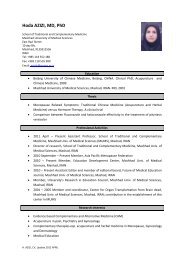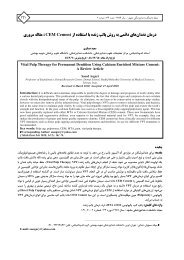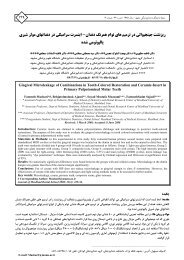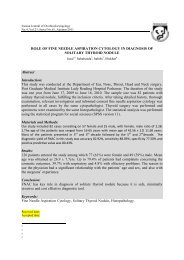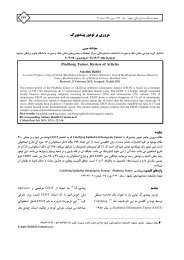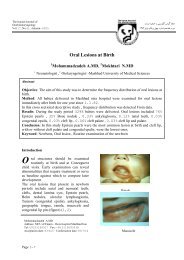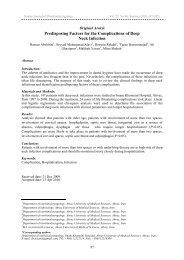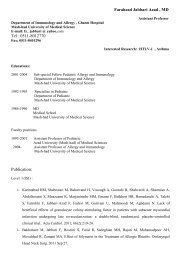The essential oils compositions of Iranian Oregano (Origanum ...
The essential oils compositions of Iranian Oregano (Origanum ...
The essential oils compositions of Iranian Oregano (Origanum ...
Create successful ePaper yourself
Turn your PDF publications into a flip-book with our unique Google optimized e-Paper software.
<strong>The</strong> <strong>essential</strong> <strong>oils</strong> composition <strong>of</strong> <strong>Iranian</strong> <strong>Oregano</strong><br />
μg ml-1). All <strong>of</strong> the extracts exhibited almost<br />
the same pattern <strong>of</strong> antioxidant activity as<br />
ascorbic acid. Regarding free radical<br />
scavenging activity, superiority <strong>of</strong> the<br />
<strong>essential</strong> <strong>oils</strong> could be attributed to the<br />
presence <strong>of</strong> oxygenated monoterpens e.g.<br />
carvacrol and other chemicals such as γ-<br />
terpinene, β - pinene and thymol as they<br />
comprise major constituents <strong>of</strong> the <strong>oils</strong><br />
(Table 2).<br />
Table2. <strong>The</strong> main chemotypes and their<br />
components <strong>of</strong> the known <strong>essential</strong> <strong>oils</strong> <strong>of</strong><br />
O.vulgare L. plants under study in Iran.<br />
percentage<br />
29.85<br />
20.94<br />
12.17<br />
11.67<br />
23.54<br />
20.50<br />
15.41<br />
9.26<br />
6.28<br />
59.37<br />
18.36<br />
6.65<br />
58.51<br />
11.46<br />
9.56<br />
67.09<br />
7.71<br />
7.67<br />
Chemotypes<br />
Carvacrol<br />
γ-Terpinene<br />
α-Himachalene<br />
β - pinene<br />
Carvacrol<br />
γ-Terpinene<br />
Thymol<br />
Germacrene D-4-<br />
ol<br />
β - pinene<br />
Carvacrol<br />
γ-Terpinene<br />
Cedrene<br />
Carvacrol<br />
Humulene<br />
γ-Terpinene<br />
Carvacrol<br />
γ-Terpinene<br />
Humulen<br />
plants a<br />
(I)- O.v-F<br />
(II)- O.v-W 1<br />
(III)- O.v-W 2<br />
(IV)- O.v-W 3<br />
(V)- O.v-W 4<br />
a<br />
- <strong>The</strong> growing localities are shown in the<br />
footnotes <strong>of</strong> the Table-1.<br />
Figure1. DPPH radical scavenging reaction<br />
I n h i b i t i o n %<br />
100<br />
99<br />
98<br />
97<br />
96<br />
95<br />
94<br />
93<br />
92<br />
91<br />
90<br />
O .v F<br />
O.v W1<br />
O.v W 2<br />
O.v W 3<br />
O.v W 4<br />
Vit C<br />
<strong>Origanum</strong> Vulgare L. Plants<br />
Figure 2. Antioxidant activity <strong>of</strong> O. vulgare L.<br />
<strong>essential</strong> <strong>oils</strong> defined as inhibition percentage in<br />
DPPH radical scavenging assay.<br />
Discussion<br />
<strong>The</strong> <strong>essential</strong> <strong>oils</strong> from <strong>Origanum</strong> vulgare<br />
L. plants collected in 5 localities in<br />
piranshahr, west Azarbaijan (Iran) contained<br />
carvacrol (ranging from 23.54% to 67.09%)<br />
as the main constituent (Table1,2). <strong>The</strong><br />
plants with a relative high percentage <strong>of</strong><br />
carvacrol in <strong>essential</strong> oil were collected in 3<br />
locations: O.v-W 2 (59.37%), O.v-W 3<br />
(58.51%), O.v-W 4 (67.09%). <strong>The</strong> two major<br />
constituents (carvacrol, γ-terpinene) <strong>of</strong><br />
<strong>essential</strong> <strong>oils</strong> were the same in all samples<br />
from 5 localities (Table1,2). <strong>The</strong> oxygenated<br />
and hydrocarbon monoterpenes contributed<br />
35.34% and 33.45% in oil sample collected<br />
from field or cultivated plants (O.v-F)<br />
followed by sesquiterpene hydrocarbons and<br />
oxygenated sesquiterpenes (15.53% and<br />
8.82%), respectively. Carvacrol (29.85%)<br />
was the major oxygenated monoterpenoid<br />
and γ-terpinene (20.94%) and β-pinene<br />
(11.67%) were the major monoterpene<br />
hydrocarbons. Of the 24.35% sesquiterpenes,<br />
α-himachalene (12.17%), was the major<br />
component <strong>of</strong> this fraction. In the sample<br />
AJP, Vol. 1, No. 2, Autumn 2011<br />
111



